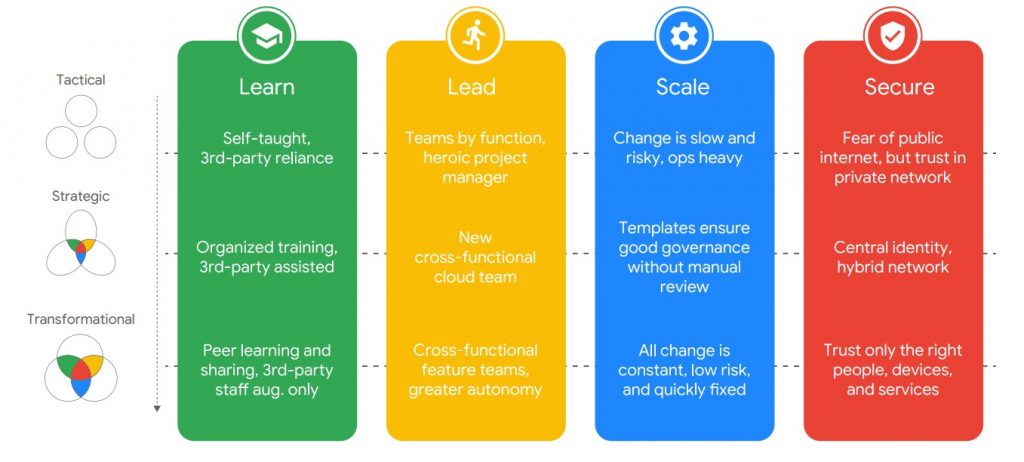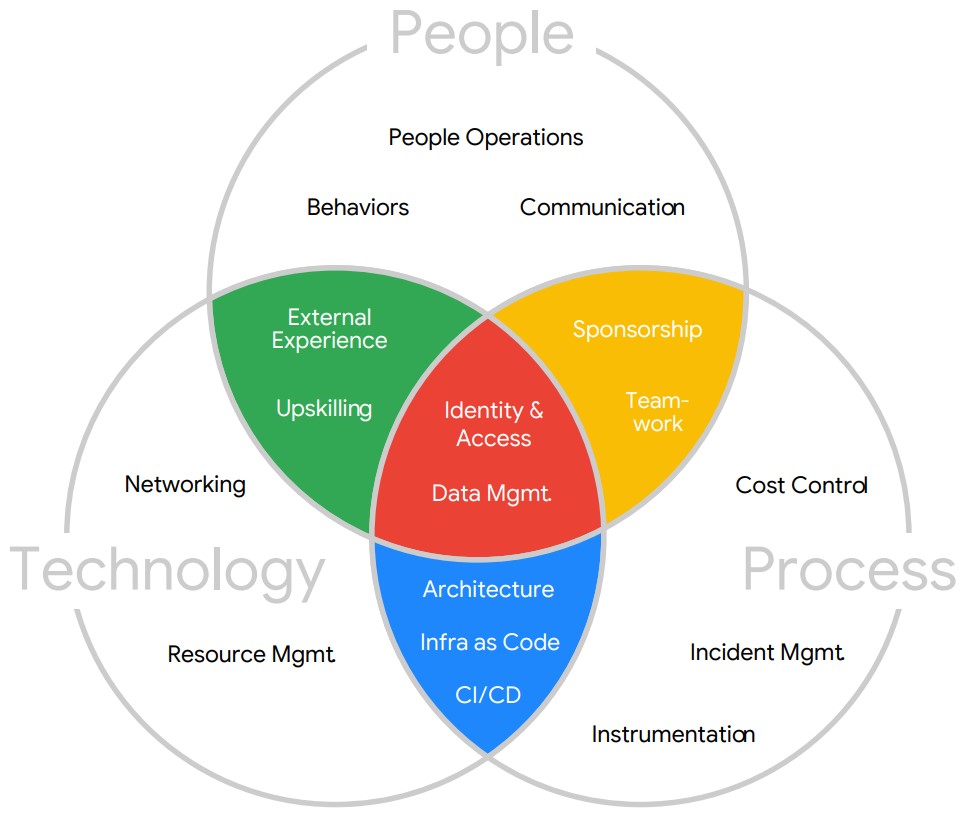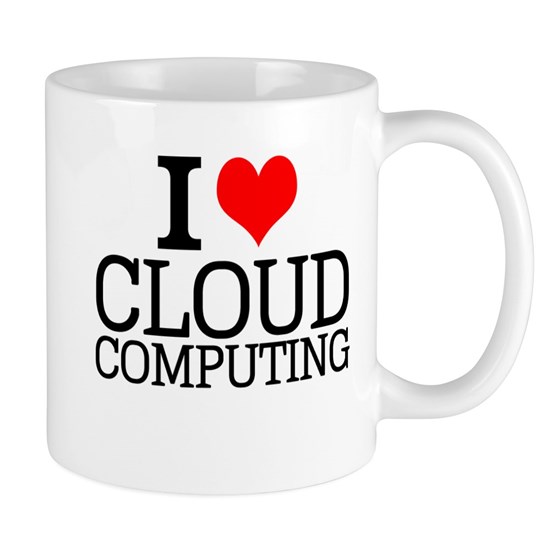TL;DR
Utilise the Google Cloud Platform (GCP), Amazon Web Services (AWS) and Microsoft Azure Cloud Adoption Frameworks and their collective experience with thousands of customers to help plan your successful cloud journey.
- Priorities: Often it is tempting to focus on work that is the easiest to understand, whereas the greatest benefit is focusing on the work that will allow you to safely and repeatably make changes.
- Secure: Give time and consideration to how you will secure your cloud implementation, including how you will manage data.
- Continuous, Safe, Repeatable Change: Trying to create a cloud operating model without being able to make continuous, safe and repeatable change will likely lead to the creation of many manual procedures and processes that go against modern practices and are difficult to scale.

Priorities
The Google Cloud Adoption Framework provides a valuable reference point to help prioritise work associated with your cloud journey. Readiness for success in cloud is determined by current business practices in 4 themes. For each theme, those practices will fall into one of the following phases:
- Tactical: Individual workloads are in place, but no coherent plan encompassing all of them with a strategy for building out to the future. The focus is on reducing the cost of discrete systems and on getting to the cloud with minimal disruption. The wins are quick, but there is no provision for scale.
- Strategic: A broader vision governs individual workloads, which are designed and developed with an eye to future needs and scale. You have begun to embrace change, and the people and processes portion of the equation are now involved. IT teams are both efficient and effective, increasing the value of harnessing the cloud for your business operations.
- Transformational: With cloud operations functioning smoothly, you’ve turned your attention to integrating the data and insights garnered from working now in the cloud. Existing data is transparently shared. New data is collected and analyzed. The predictive and prescriptive analytics of machine learning applied. Your people and processes are being transformed, which further supports the technological changes. IT is no longer a cost center, but has become instead a partner to the business.
Looking at this it can be daunting to understand where to start, or indeed where to go if you have already started your cloud journey. Fortunately GCP provide some guidance on this via the use of some key individual workstreams (which they refer to as epics), including a useful depiction of them below:

Observe how the coloured segments map to Learn, Lead, Scale and Secure. While all of the epics are important, the greatest focus should be given to coloured segments. Often you will find that it is tempting to focus on the epics on the outer edge as these are the easiest to understand, whereas the greatest benefit will be obtained by focusing on the epics towards the centre.
Secure
In your journey to cloud, you will have choices of whether to adopt a Hybrid-Cloud (mixture of on-premises infrastructure and cloud), Single Vendor (e.g. AWS or Azure) or multi-vendor platform (e.g. AWS, Azure, GCP). In all cases, security of your cloud implementation should be paramount. From the GCP Cloud Adoption Framework:
“In the narrow sense, the security of your cloud estate is determined by your ability to guarantee who may perform which action on which resource (identity and access management) and your understanding of the data that needs
protecting, ensuring it is appropriately catalogued, encrypted, and guarded from exfiltration, to name just a few considerations.”
In supporting identity and access management, the concept of a zero trust security architecture (trust is always obtained, not implied) has gained much popularity. At its heart, this must be supported by a single strong source of user identity. Of particular note here is Okta, whose vision is to become one of the five or six “Identity Clouds”.
In parallel to securing your cloud implementation, you should give time and consideration to data management. Data Management encompasses ensuring your data is secured, audited and governed appropriately, including ensuring that the data you store is of use to your organisation. From the GCP Cloud Adoption Framework:
“As an organization, being a good custodian of the data you hold is not just good practice. It makes good
business sense as well. Poor data management can lead to breaches or other issues that can result in
reputational damage for your business or regulatory sanctions.“
Continuous, Safe, Repeatable Change
Mention the term “Cloud Operating Model” and you may start to think about Change Management or the people and processes in your organisation that will allow the operation of your cloud implementation. While these are important, the GCP Cloud Adoption Framework highlights 3 important epics that must be part of our Cloud Operating Model – CI/CD (Continuous Integration/Continuous Delivery), Infrastructure as Code, Architecture.
These 3 epics can be summarised as the ability to be able to make continuous, safe and repeatable change. While many organisations manage to complete a successful cloud implementation, the most successful implementations want and plan for continual change. An outline of the meaning behind these 3 epics is provided below:
- Continuous Integration / Continuous Delivery (CI/CD) – A series of steps that must be performed in order to deliver a new version of software. CI/CD is typically composed of one or more delivery pipelines. A Delivery Pipeline is a set of automated steps to deliver changes to a particular product, feature or service. Modern services typically have multiple pipelines to allow smaller, incremental changes, thereby reducing risk and increasing feedback
- Infrastructure as Code – Define your platform using machine-readable definition files, rather than physical configuration or interactive/GUI-based tools. Advantages include removing implicit knowledge and risks associated with manual configuration
- Architecture – A broad understanding of the overall technical and business implementation, including an understanding of the technical strategy and roadmap that underpins your business strategy and roadmap.
Trying to create a cloud operating model without being able to make continuous, safe and repeatable change will likely lead to the creation of many manual procedures and processes that go against modern practices and are difficult to scale.
Published: July 2021

